Northwest New Mexico had a couple of fascinating historical locations that we visited while staying in Bloomfield – Chaco Culture National Historical Park and Aztec Ruins National Monument.
After Bloomfield we moved on to Los Alamos, a city about an hour west of Santa Fe and home to the Manhattan Project which created the atomic bomb. It’s also home to Bandelier National Monument which is where Ancestral Puebloans – who also lived in Chaco Canyon and Aztec – once resided. It’s a really interesting site where you can explore the cliff dwellings, learn history, take in beautiful views of the Frijoles Canyon and more.
As with other National Park Service locations we’ve visited during COVID, the visitor center was closed. However, there was a desk outside with information about the Monument, as well as ink and stamps so we could stamp our National Parks Passport.
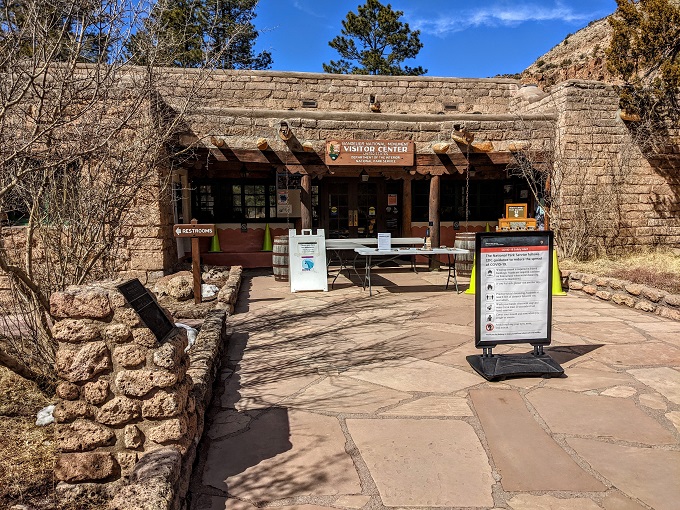
Although the visitor center was closed, the Park Store was open. The desk outside the visitor center had a free leaflet about the site in general, but while in the Park Store I bought a Main Loop Trail Guide for $1. That’s well worth the investment as there are 21 numbered spots while walking along the Main Loop Trail (also known as the Pueblo Loop Trail) and so the guide helps provide a lot more context about what you’re looking at.
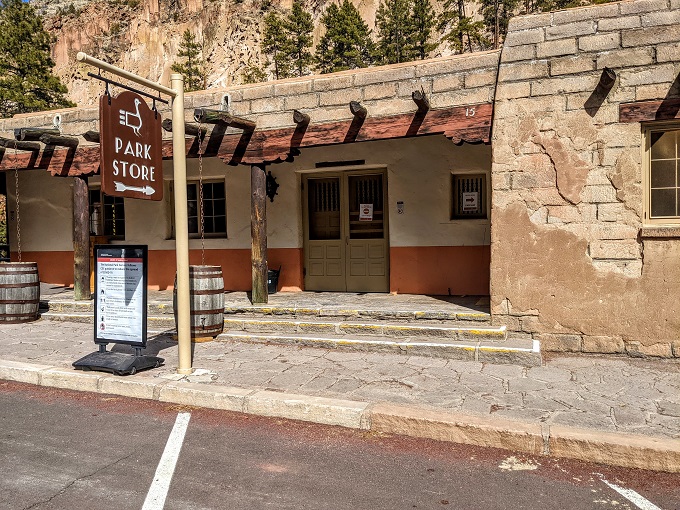
Pueblo Loop Trail
Dogs aren’t allowed on any trails at Bandelier National Monument, so we left Truffles back at our Airbnb. Shae and I set off on the Pueblo Loop Trail which starts off paved.
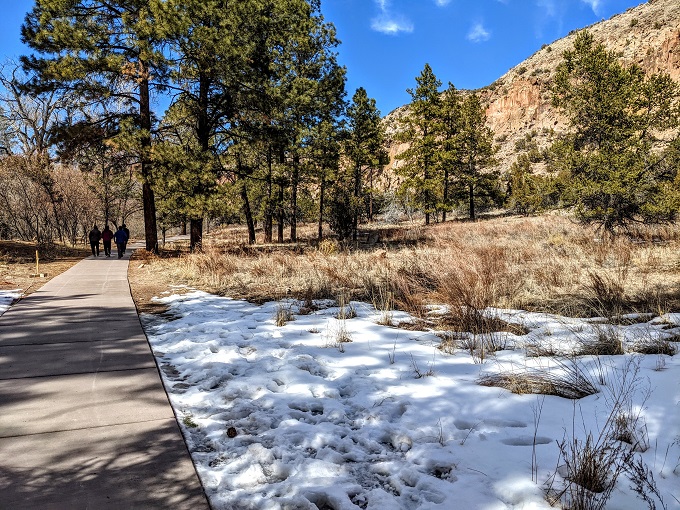
Keep an eye out for the numbered signs which correlate with information in the trail guide. It’s not long before you’ll start coming across Ancestral Puebloan buildings like this kiva.
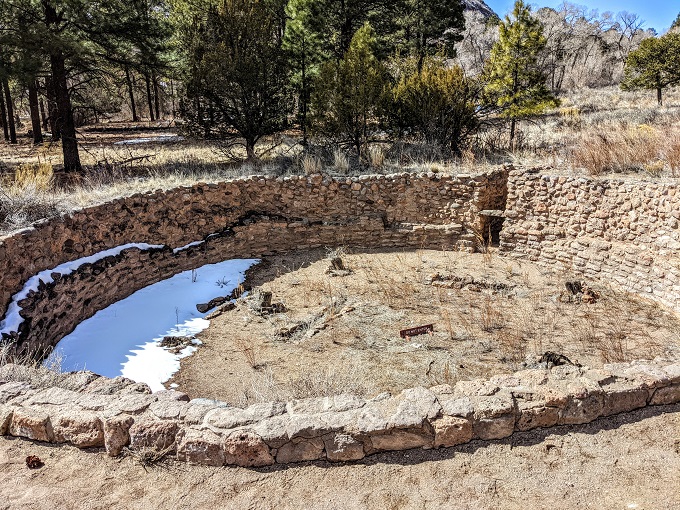
Just past the kiva are even more buildings which were part of the village of Tyuonyi (pronounced qu-weh-nee).
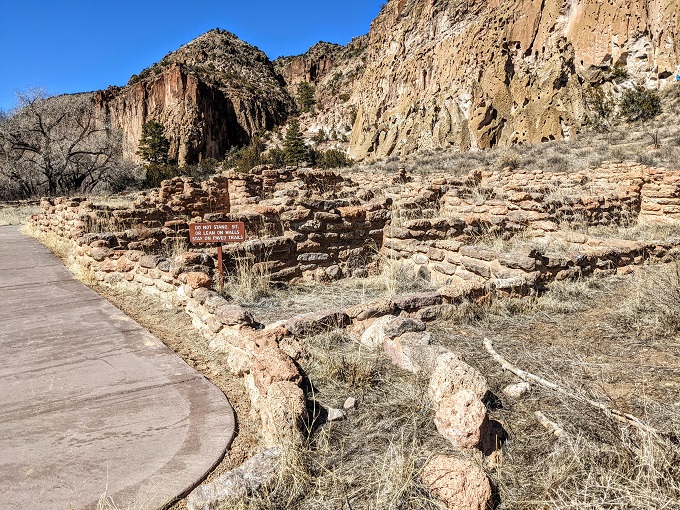
The buildings were reminiscent of those we saw in Chaco Canyon and Aztec which isn’t surprising as the Ancestral Puebloans who lived in Tyuonyi and Aztec had cultural links with those who lived in Chaco Canyon.
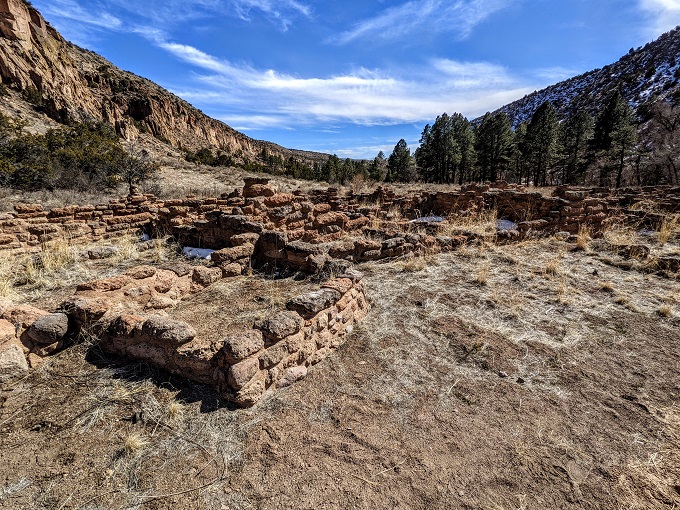
The trail splits in two directions soon after those ruins. The loop trail heads off to the right and curves back around up and to the left along the cliff wall. You can’t see it in the photo below, but the trail continues halfway up the rock face.
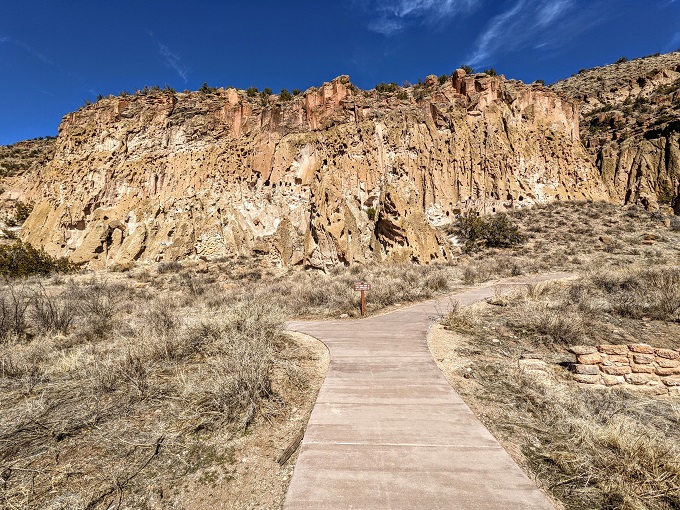
One of the best features of Bandelier National Monument is the opportunity to explore the cliff dwellings, also known as cavates (pronounced cave-eights). There are sturdy wooden ladders for you to climb up so that you can get a better look inside.
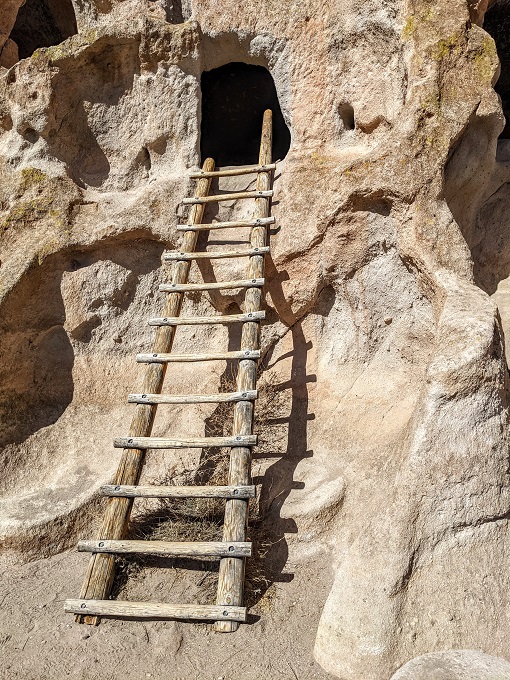
The cavate’s lower walls were often covered with plaster and painted, while the ceilings were blackened with smoke. Smoking the ceilings helped make them less crumbly by hardening the rock.
The cavates had a hole in the floor which I’m guessing is where a fire was kept for heat and cooking.
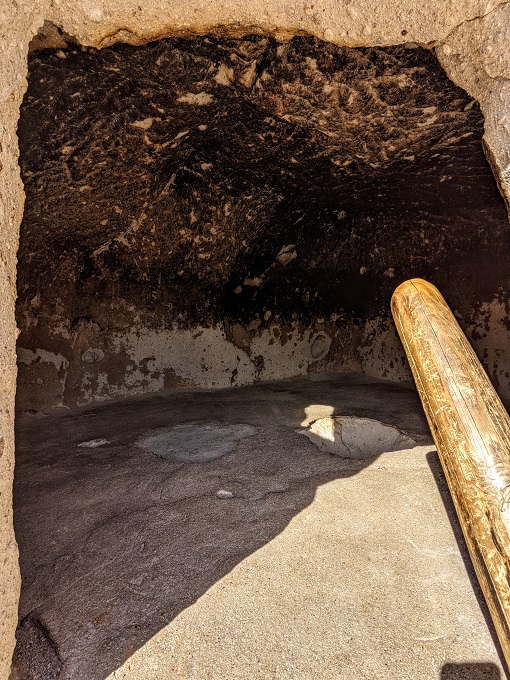
These cavates often had a stone home built in front of them. The next stop on the trail has a home that was reconstructed in 1920 to help give an idea of what those homes once looked like.
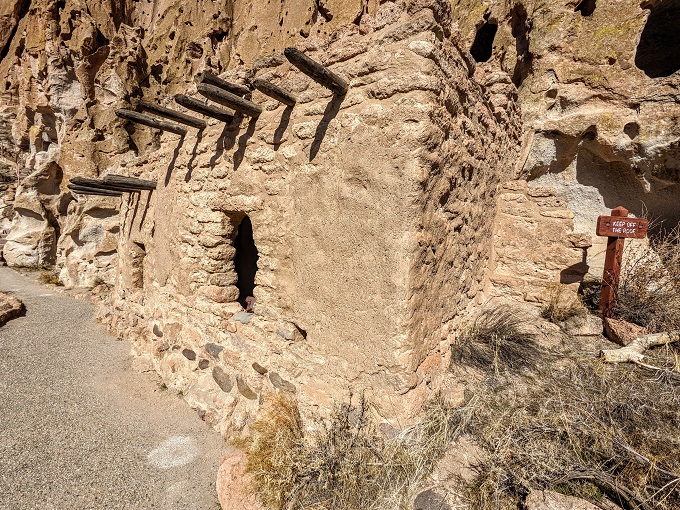
After seeing the first cavate, I’d wondered how the Ancestral Puebloans protected their homes from the elements seeing as they seemed fairly exposed, so it made more sense once we discovered that they often had a stone house like this one built in front of them.
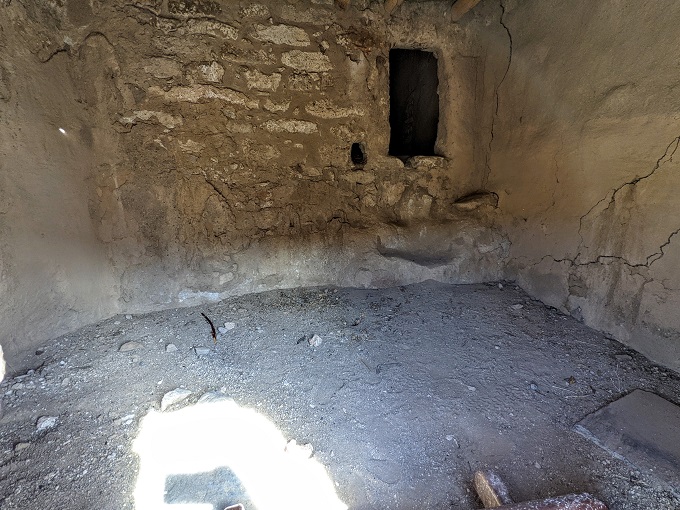
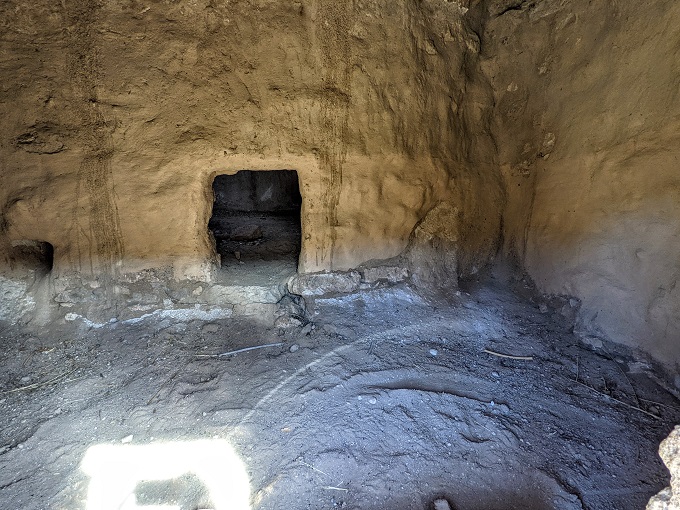
The Pueblo Loop Trail continued towards another cavate you could climb a ladder up to and walk around inside.
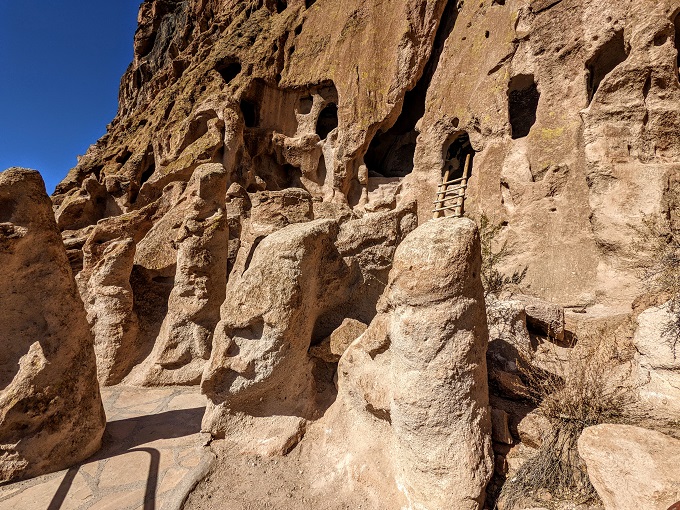
This cavate was larger than the previous one with a couple of additional rooms on either side.
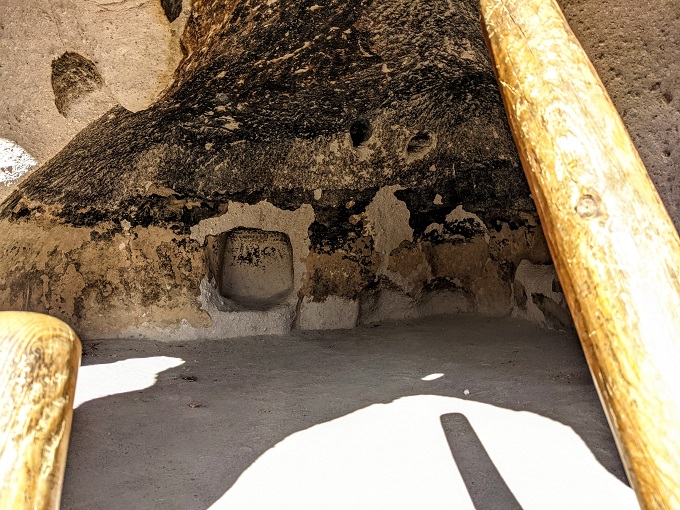
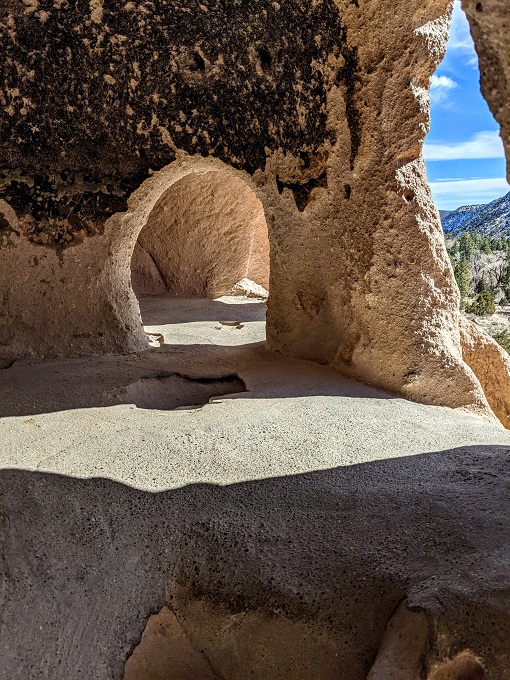
The views out over Frijoles Canyon were absolutely stunning and looked down over the village of Tyuonyi which we’d walked through earlier.
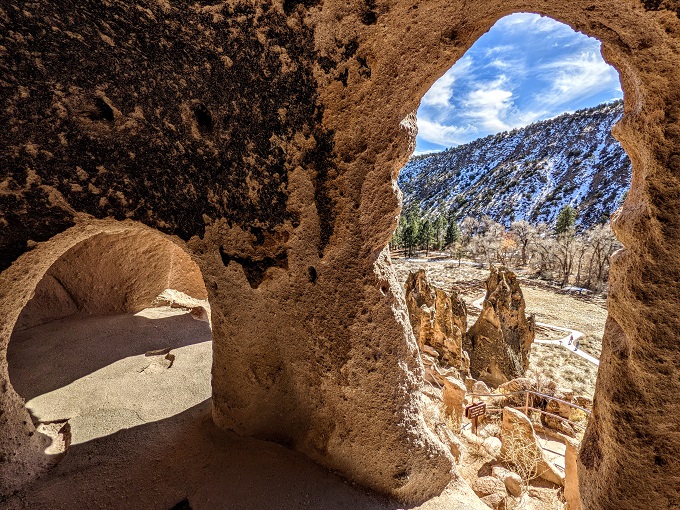
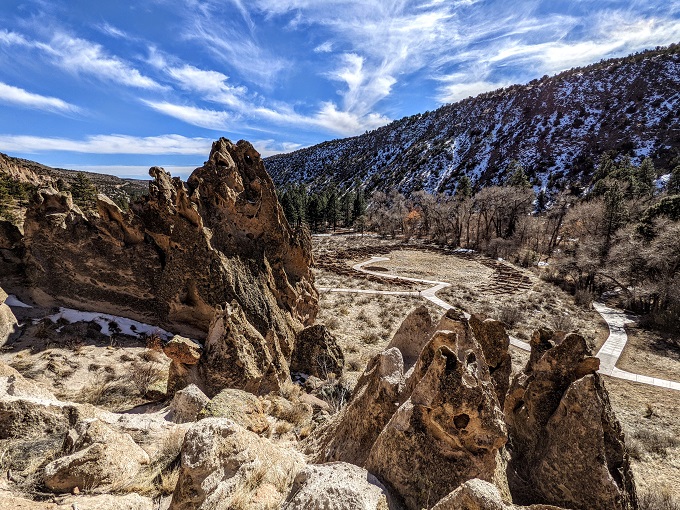
Next up was an even larger cavate called Cave Kiva. This cavate has been reconstructed and gets smoked and replastered regularly due to the graffiti in the cavate (as can be seen in the photo below).
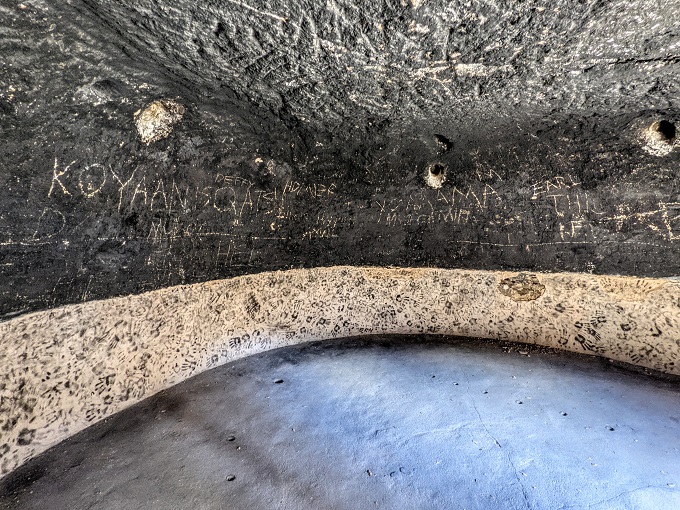
The floor had a row of holes. These are where anchors were used to help keep weaving straight.

While walking along the trail, the cliff walls had rows of holes. These rows indicated how many stories each home had; by building along the rock face, the Ancestral Puebloans were able to construct taller buildings as the rock face behind gave additional stability.
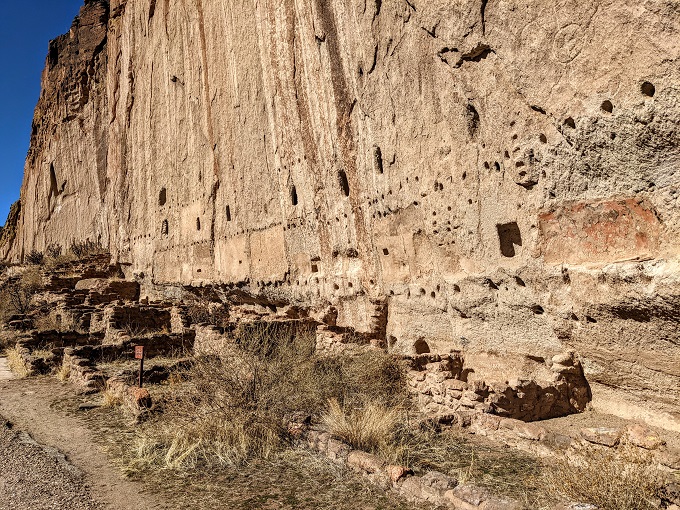
If you visit Bandelier National Monument, keep an eye out at this section as there are quite a few petroglyphs that can be seen.

Along this same rock face there are a couple of pictographs that have been preserved. The one in the photo below was found behind a layer of plaster and is now covered by a sheet of glass or plastic which is why it’s still in such good condition.
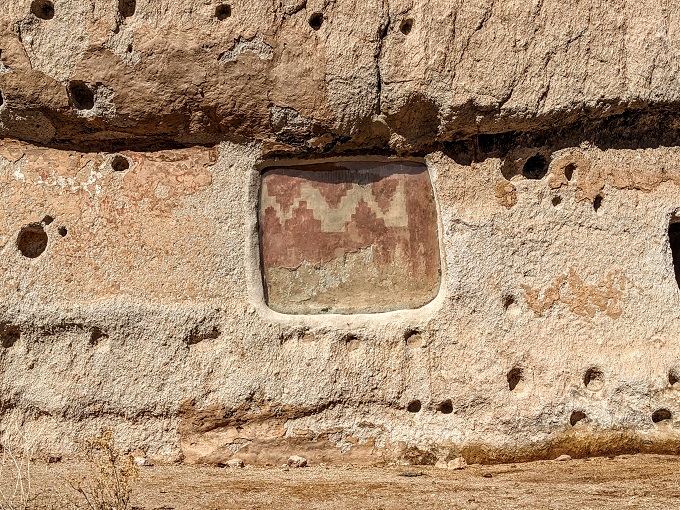
The pictograph is one of the final things to see along the Pueblo Loop Trail. At that point you have a few choices as to what to do next. One option is to return along the route you already took which is what the National Park Service recommends doing in winter months when it’s icy further on the trail.
We visited at the end of February 2021. Although there was still some snow on the ground, it wasn’t icy and so we continued along the trail which crosses Frijoles Creek.
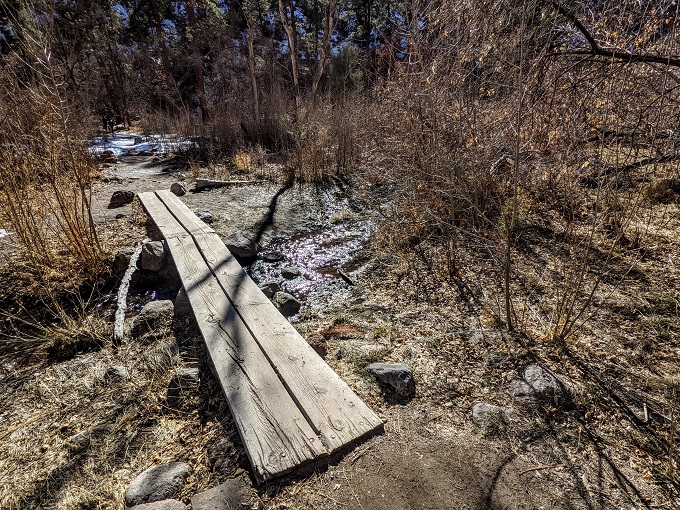
Just past the creek the trail splits in two. You can turn left and take the Nature Trail back to the parking lot or you can turn right and head to the Alcove House which was once known as the Ceremonial Cave.
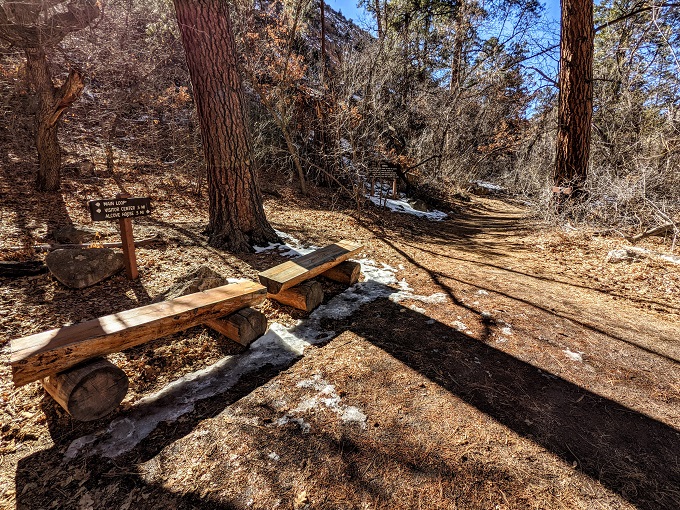
Alcove House
Shae and I wanted to check out the Alcove House, so we headed up the half-mile trail to the right. If you need a restroom at this point, you’ll find one along the trail.
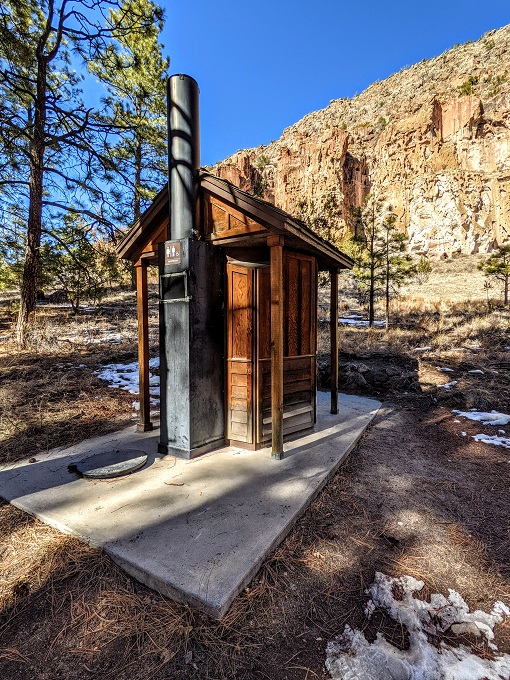
One thing you should be aware of when visiting the Alcove House is that you have to climb four wooden ladders which head up 140 feet. You see the alcove about two-thirds of the way up the rock face in the photo below? That’s where you’ll be heading.
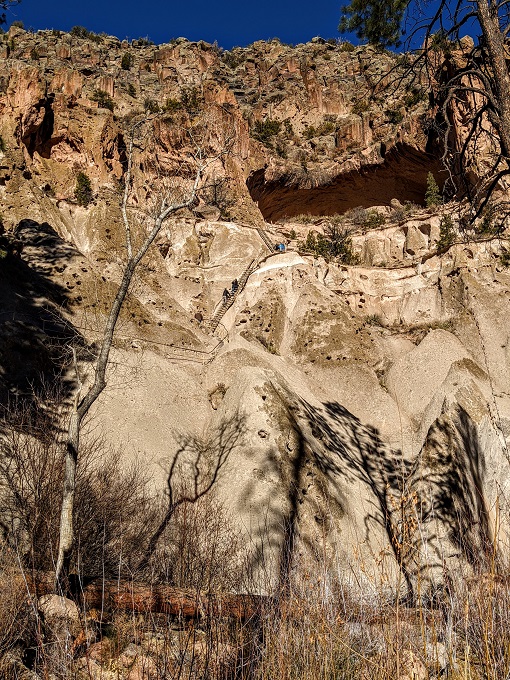
While it might look a little daunting, it’s really not bad. Shae doesn’t care for heights, but she was able to head up and down slowly but surely without any problem. There is a sign warning you that you shouldn’t proceed if you’re scared of heights or have health issues which might prevent you from being able to climb up and down the ladders.
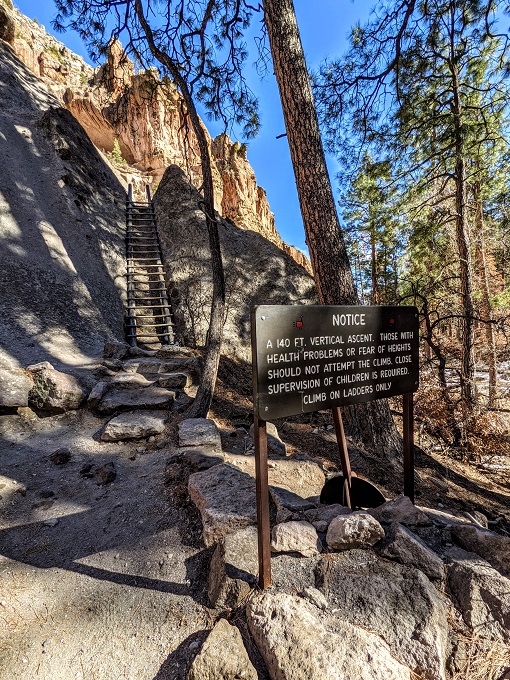
The ladders are at a reasonable angle, so you’re able to lean forward when climbing up and down rather than them being perpendicular to the ground. All four of the ladders are fixed firmly in place against the rock face, so there’s no danger of the ladders moving.
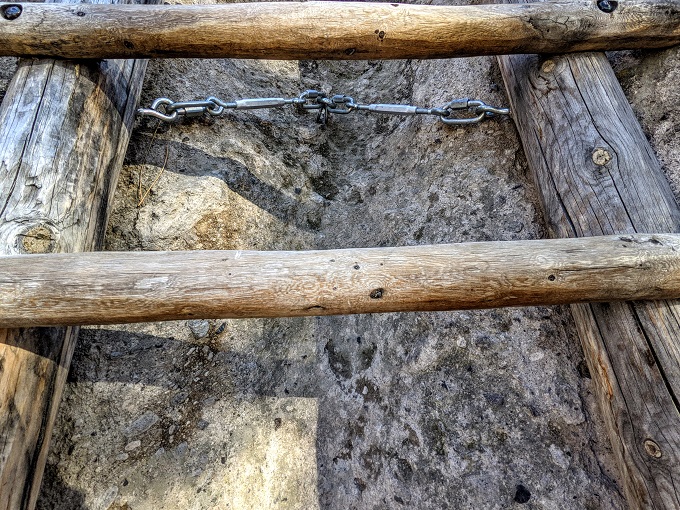
After the first ladder there’s a narrow section you have to walk through to get to the second ladder. Although the pathway is narrow, there’s a handrail all the way along for safety.
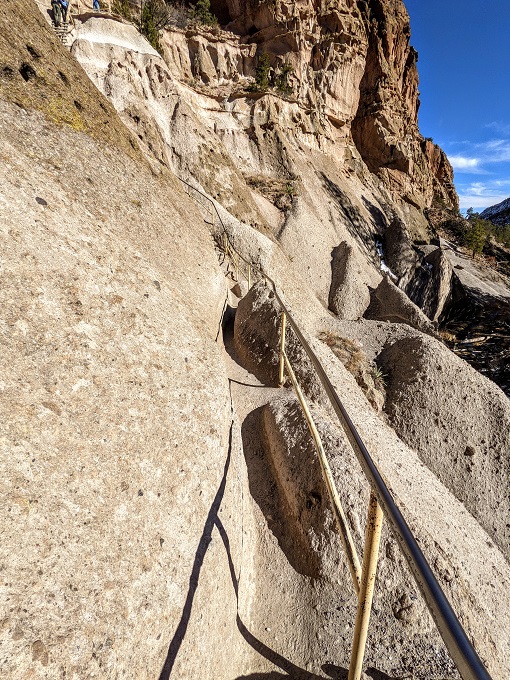
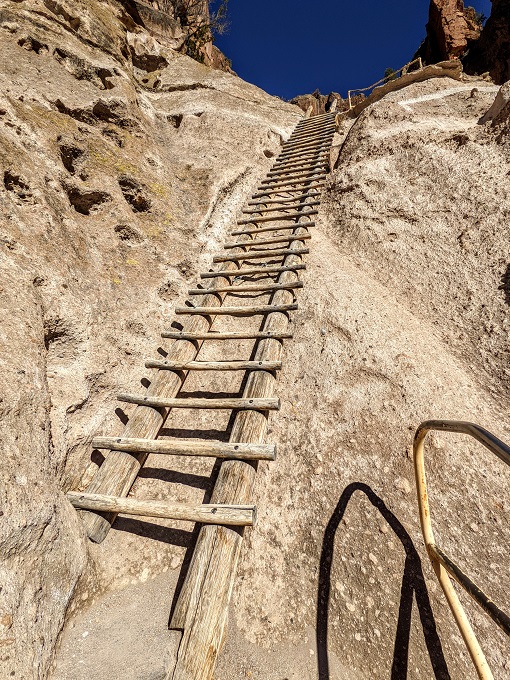
Provided you aren’t too daunted by the height, be sure to take a look around once you’re on the platform at the top of each ladder as the views are lovely.
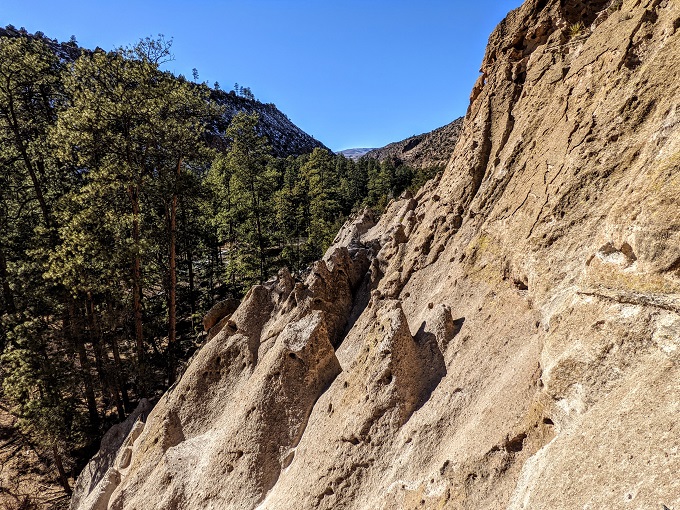
The first three ladders are all fairly long…

…whereas the fourth and final ladder is much shorter.

If you make it this far, congratulations – you’ve reached the Alcove House!
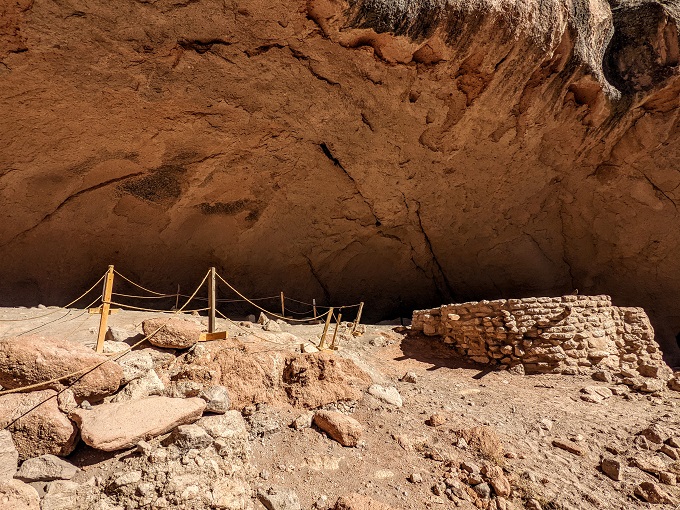
Some sections were roped off, but there were still areas we could explore.
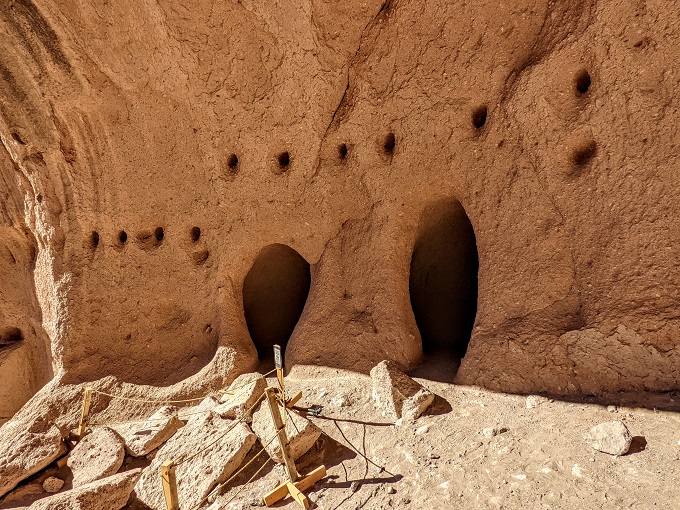
It sounds like in the past it was possible to look inside the kiva in the Alcove House, but it was only viewable from a distance when we visited.
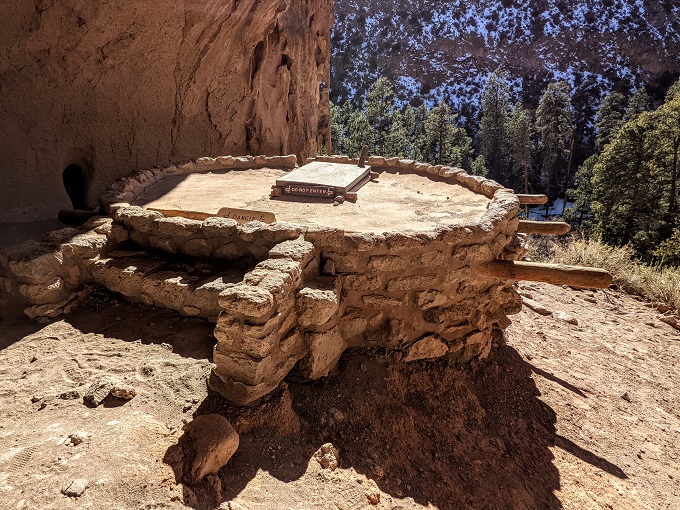
After spending a few minutes in the Alcove House, it was time to head back down all the ladders. We then took the Nature Trail back to our car which had a number of information boards providing details about the geology, flora and fauna of the area.
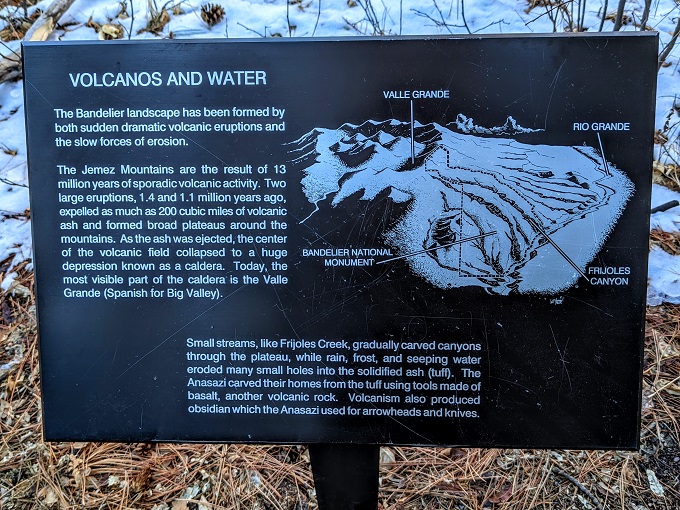
Final Thoughts
Shae and I didn’t know much about Bandelier National Monument before visiting, but we’re certainly glad we spent a few hours there exploring the site. Being able to go inside a number of the cavates was fascinating and helped give a much better idea of what life was like for the Ancestral Puebloans.
Frijoles Canyon is beautiful, with the Pueblo Loop Trail giving you some amazing views of the canyon from higher up. The Alcove House is also definitely worth checking out provided you can deal with the (not very scary) heights.
Bandelier National Monument has several other hiking trails – including one to a waterfall – which we didn’t have time to check out that day. There’s also an outlier site called Tsankawi Prehistoric Sites; that’s part of Bandelier National Monument, but is located about 15 miles away closer to downtown Los Alamos. Tsankawi has additional cavates, petroglyphs and more, so that site is worth checking out too (read more about that in this post).
[…] Bandelier National Monument covers more than 30,000 acres, most of which is all in the same location. We visited Bandelier while in Los Alamos and did the Pueblo Loop Trail and then took the offshoot to the Alcove House (see this post for more about those). […]